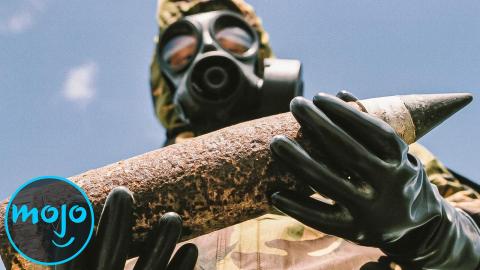Top 10 Cruel Weapons BANNED From Modern Warfare

#10: Blinding Laser Weapons
Although sci-fi movies have made the prospect of using weapons that rely on lasers look cool for decades, the reality is much more sobering. In the real world, there was a huge physical concern. Several countries became concerned that soldiers would use laser weapons to significantly reduce or permanently eliminate an enemy’s ability to see. To prevent this from happening, over 100 countries agreed to the “Protocol on Blinding Laser Weapons”. This was a rare occasion where the ban was preventative instead of being introduced after people had suffered side effects. While some experts think the danger of similar weapons still remains, this agreement was still seen as a major victory.
#9: “Expanding” & Explosive Small Artillery
In 1868, delegates from most major European powers and the Ottoman Empire met in St. Petersburg, Russia to talk about a potentially horrific subject. Several countries had started using bullets that explode on contact. In the St. Petersburg Declaration, the nations present decided that explosive rounds shouldn’t be smaller than 400 grams. For reference, that’s about the size of a Coke can. A similar issue arose in 1899. Expanding bullets, which were also nicknamed Dum Dum rounds, do exactly what their original name suggests when they hit an enemy. The resulting wounds tended to be larger and more debilitating. While the Hague Convention of 1899 pushed to prevent expanding bullets in war, the rounds are still used by hunters and law enforcement today.
#8: Weapons That Leave Behind Non-Detectable Fragments
Top 10 Coolest Ancient Warrior Weapons
In modern warfare, a soldier may be at risk of leaving the battlefield with pieces of artillery or explosive weapons inside of them. Traditionally, the fallout from these injuries could be seen on an x-ray. But developments in warfare led to the creation of weapons that could produce undetectable fragments such as plastic. Not only would these items cause serious physical damage, but soldiers could get nasty infections too. And since the fragments can’t typically be picked up on standard x-rays, finding and extracting it could be nearly impossible. All of these negatives led to what’s known as “ Protocol I of the Convention on Certain Conventional Weapons”. It prohibits weapons where the ‘primary’ effect is to produce undetectable fragments.
#7: Land Mines
Top 3 Facts About Toy Story Land
Land mines have existed in various forms for centuries. In that time, they’ve gone from being a disruptive and unreliable tool to becoming a modern plague. Not only are dozens of countries around the world littered with them, but eighty percent of victims are civilians. Mines can also stay undetected for years and cause indiscriminate damage. For these reasons and more, there was a large push to completely remove the explosive weapons from the battlefield in 1997. However, big world powers like the United States and Russia chose not to sign at the time. The policy surrounding mines is still contentious to this day. Modern conflicts like the Russian Invasion of Ukraine has only sparked more discussions about the continued use of these explosives.
#6: Cluster Bombs
Cluster bombs are a particularly nasty form of warfare. They are shot from the ground by artillery or dropped by planes. As the name suggests, cluster munitions open midair and split into multiple smaller bombs. One of the main determining factors for a weapons ban is the question “Does this weapon kill indiscriminately?” With cluster bombs, the answer is doubly yes. The widespread use of cluster bombs makes civilian deaths all but inevitable. A ban for them was put forward at a 2008 Convention. At the time, over a dozen nations still refused to remove cluster bombs from their arsenal.
#5: Poisoned Weapons
Historic accounts suggest that people have been using poisoned weapons as early as 300 BC. Eventually, these vicious weapons became employed in war. Depending on the poison, victims could be forced to endure a lot of agony or even die. One of the oldest weapon bans in human history actually prohibited poisoned bullets. In 1675, a war between France and the Holy Roman Empire ended with the Strasbourg Agreement. The two nations also agreed to prohibit the use of poisoned bullets in future battles. That extended to the rest of the world with the 1907 Hague Convention.
#4: Incendiary Weapons
Fire has been weaponized for as long as there has been war. In ancient times, it was employed through use of hot pitch, oil, and resin. Flammable material was affixed to projectiles, used to soak pre-prepared ground, or even dumped directly on the enemy.. But fire is an unbearably painful weapon that is not always easily controlled. In modern times, incendiaries evolved into firebombs, napalm, and flamethrowers. Napalm and flamethrowers in civilian areas were banned in Protocol III to the Convention on Certain Conventional Weapons. But it doesn’t exactly ban using fiery weapons on soldiers and vehicles. Additionally, incendiary weapons like White phosphorus are still deployed in conflicts all over the world.
#3: Poison Gas & Certain Chemical Weapons
Technically speaking, poison gas was part of the 1907 ban on poisoned weapons. But that didn’t stop either side from employing gas bombs during World War I. The results were horrific. Chlorine and mustard gasses were used to deadly effect. During the conflict, approximately 1.3 million casualties were caused by chemical agents. In time, international officials saw the agonizing physical pain and long term neurological damage first hand. Public opinion led to a more widespread ban in the 1925 Geneva protocols. However, Geneva didn’t ban weapons development or stockpiling. Chemical Weapons were used by the Axis Powers in WWII, by Sadam Hussein in Iraq, and Assad in Syria. In 1993, the Chemical Weapons Convention expanded the ban. Most stockpiles have since been destroyed.
#2: Biological Weapons
Biological warfare involves weaponizing bacteria and viruses. These classes of weapons may go down as one of the most dangerous tools of war ever existed. One of the first known uses of biological warfare was the 1346 Siege of Caffa by the Mongols. In this case, bodies riddled with Black Death were left in cities. Millions of people ultimately died in the aftermath. British and American soldiers also both gave smallpox blankets to Indigenous peoples and wrecked entire communities. Since biological agents are not easily contained to combatants, they can quickly spread out of control. The 1972 Biological Weapons Convention sought to supplement and reinforce the Geneva Protocols against them.
#1: Dirty Bombs & Salted Bombs
Top 10 Dirty Secrets Banks Don't Want You To Know
The 2022 Russian invasion of Ukraine also ignited international discussions about dirty bombs. Unlike a nuke, a dirty bomb doesn’t actually involve the use of a nuclear explosion. Instead, it essentially consists of dangerous materials wrapped around a conventional explosive. They are designed to indiscriminately spread radiation. Since there is no real way to control the spread, dirty bombs are an incredibly real threat to civilians. While these terrible weapons are not explicitly banned, international legal experts believe that it’d be almost impossible to use one legally. It’s the hope of many people around the world that dirty bombs never become regular tools of war.




